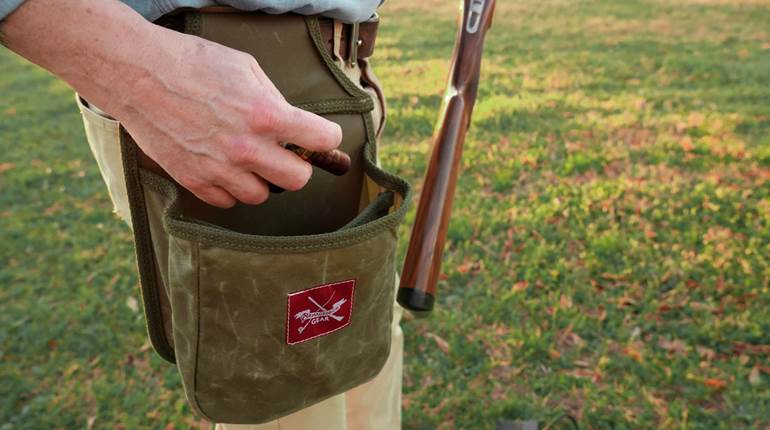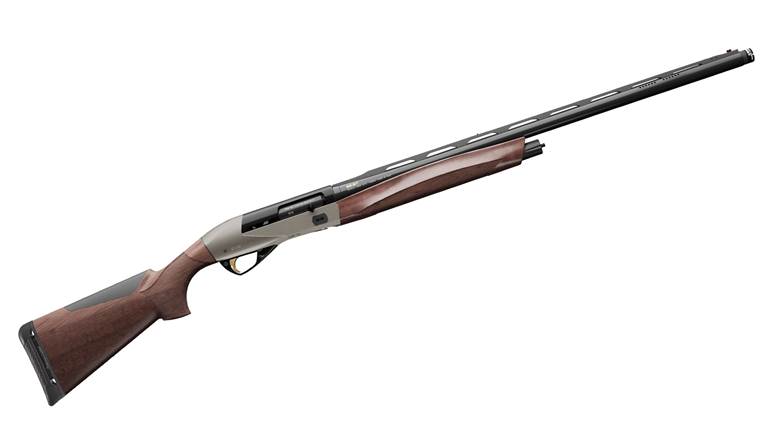
Top: The Winchester Model 94 XTR Big Bore carbine was the first, and one of the few, guns chambered in the .375 Win.
I’m here to praise the .375 Winchester, not lay it to rest, although over the years a lot of dirt has been shoveled on the cartridge for various reasons.
The .375 Win. cartridge was introduced in 1978 in the Winchester Model 94 XTR Big Bore carbine. Here was a cartridge that fired considerably heavier bullets than the .30-30 Win., and in a rifle that weighed a packable 6.5 lbs. I bought my .375 Big Bore off the used gun rack at a local sporting goods store and became a fan of the cartridge once I started shooting and hunting with the rifle.
The .375 Win. (left) stands in next to some large competition, such as the .45-70 Gov’t. (center) and .35 Remington (right).
The .375’s maximum average pressure is 52,000 copper units of pressure (CUP), much higher than the .30-30 Win.’s 38,000 CUP. To contain the .375’s relatively high pressure the rear of the Big Bore’s receiver, surrounding the rear vertical locking lugs, is about a quarter of an inch thicker than the receiver of regular Model 94s. The XTR was an upscale edition of the Model 94 with checkering on its straight grip and forearm, high gloss bluing and a red thin butt pad. In 1983 the Angle Eject feature added so cases ejected out the right side of the receiver to allow mounting a scope over the receiver. A raised comb and a transfer-bar safety were also added to these Angle Eject carbines. But I was one of the few who liked the cartridge, because it was dropped from the Model 94 line after a short 9-year life in 1986.
The .375 Win. (left) was intended as a modern rendition on the old .38-55 Win. (right). A .38-55 cartridge will fit in a .375 chamber, however, its longer length makes it dangerous to shoot in a .375. The .375’s high pressure makes it dangerous to shoot in a rifle chambered in .38-55.
For an even shorter time, other rifles were chambered in .375. Marlin chambered its 336 lever-action in .375 and called it the Model 375 from 1980 to ’82. Ruger chambered it in its single-shot No. 3 and Savage in its lever-action Model 99 chambered it for a short while.
The .375 Win. resembles the older .38-55 Win. and may have been introduced as a modern form of the old Winchester cartridge. Winchester initially loaded the .375 with 200-gr. Power-Point bullets with a muzzle velocity of 2,200 f.p.s. and 250-gr. Power-Points at 1,900 f.p.s. Winchester stills lists the 200-gr. load on its website. But availability is sparse. One Internet sites sells Winchesters for $60 a box, plus shipping. Buffalo Arms sells .375 ammo loaded with Barnes Original 255-gr. bullets for $60.89 for a box of 20.
Cases for the .375 Win. are difficult to find and expensive when you do. Necked out .30-30 cases work fine for low-pressure loads. The two cases on the left are .375s and the two on the right are necked out .30-30s.
The closest I came to a box of factory .375 ammunition was at a gun store a few years ago. A box of Winchester cartridges had sat on the shelf so long the print on the face of the box had completely faded. On the end of the box was a price tag of $43.
I asked the clerk, “Is that price correct?”
“Let me check,” he replied.
He returned a minute later. “Nope, that’s not the right price. It should be $58.”
Such expensive ammunition does not bode well for a cartridge’s longevity.

A Winchester Model 94 XTR Big Bore .375 shot this group (left) at 100 yards shooting Barnes Original 255-gr. bullets and Reloder 7 powder. A Winchester Model 94 XTR Big Bore .375 shot this group (right) at 100 yds. shooting Barnes Original 255-gr. bullets and Reloder 7 powder.
That leaves handloading. Cases are ridiculously expensive, if you can even find any. Thankfully, I bought 100 Winchester cases along with my rifle. But they are reserved for full-power loads because of their thick construction. Necked out .30-30 cases work in a pinch. The resulting cases average 0.05” shorter and 18 grs. lighter than factory .375 cases and work fine for reduced-pressure loads.
A Winchester Model 94 XTR Big Bore .375 shot this group at 100 yards shooting cast bullets and IMR 3031 powder.
Bullets for handloading are somewhat more available. Sierra sells a 200-gr. flat nose and Barnes its Original 255-gr. soft point. Hawk Bullets sells 180, 200 and 250-gr. flat point bullets suitable for the .375. That’s about it.
Bullets are always available when you have a bullet mold in hand. The .375’s velocities top out at about 2,100 f.p.s., which are just right for cast bullets. Lee, Lyman, RCBS and Redding SAECO sell molds that cast flat nose bullets for the .375. My Lyman 375449 mold casts bullets that weigh 267-grs., with the addition of a gas check.

A Winchester Big Bore Model 94 chambered in .375 Win. provides some serious clout in a light rifle.
I’ve shot the cast Lyman and Barnes 255-gr. bullets with 8 powders, Accurate 5744 on the fast side to W748 on the slow end. Reloder 7, by far, provided the best accuracy and highest velocities. For hunting, 30.5 grs. of Reloder 7 fired the Lyman bullet at 1,938 f.p.s. with groups of 2” to 3” at 100 yds.
The .375 and .38-55 are 2 peas in a pod. So the .375 should share the .38-55’s reputation for accurately shooting cast bullets at about 1,400 f.p.s. I loaded the .375 with the Lyman bullet with 26.0 grs. of IMR 3031to attain about that speed. Two, 3-shot groups at 100 yds. averaged 2.35”, which is pretty good for my eyes aiming iron sights.
.375 Plight
The first whitetail I shot with the .375 ran down off the ridge without missing a step. The deer’s tracks stopped after 50 yards with the deer dead next to a log. The Lyman cast bullet had poked a hole about the size of a quarter through both lungs. My son shot two whitetails with Barnes 255-gr. bullets with the same results. My son, though, looks at the .375 as a relic of an ancient era. He considers the .375’s ballistics feeble and would rather hunt with bolt-action rifle chambered in 7 mm-08 or .300 WSM.
The majority of hunters agree. The 200-gr. bullet still loaded for the .375 by Winchester really offers no better performance on game than a 170-gr. bullet from a .30-30 or 200-gr. bullet from a .35 Remington shot at the same speed. Those cartridges have well-filled the “brush cartridge” niche. Ammunition and handloading components for the .30-30 and .35 are also readily available.
Only when shooting heavier bullets does the .375 offer anything superior to some other short-range hunting cartridges. The heavy-hitter .45-70 Gov’t, though, has staked out that position. And once again, with existing ammunition and handloading components.
So while I praise the .375 Win., except for hunting rifle fanatics, the cartridge is most likely no more.
Velocities were recorded 9’ in front of the Winchester’s muzzle and are the average of 6 shots. Groups are the average of 2, 3-shot groups. *-Winchester .375 cases and **-necked-out Remington .30-30 cases used with Winchester Large Rifle primers. Temperature 55 to 60 degrees.

The .375 Win. is perfect for hunting white-tailed deer in the timber. However, several other cartridges offer the same advantages.






































